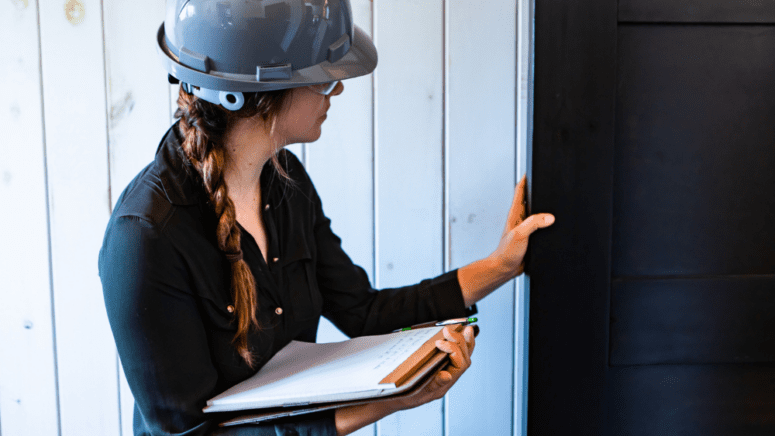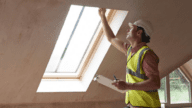What Do Home Inspectors Look For? Why These 5 Items Could Make or Break the Inspection
- Published on
- 7 min read
-
 Nichole Talbot, Contributing AuthorClose
Nichole Talbot, Contributing AuthorClose Nichole Talbot Contributing Author
Nichole Talbot Contributing AuthorNichole Talbot is a freelance writer who covers real estate, development, and design. She has created content and copy for home builders, architects, and interior design firms for eight years. When she’s not writing, you can find her sipping a cold brew coffee on home tours or vintage furniture hunting in and around Portland, Oregon.
-
 Fran Metz, Contributing EditorClose
Fran Metz, Contributing EditorClose Fran Metz Contributing Editor
Fran Metz Contributing EditorFran Metz is a freelance content writer, editor, blogger and traveler based in Las Vegas, Nevada. She has seven years of experience in print journalism, working at newspapers from coast to coast. She has a BA in Mass Communications from Fort Lewis College in Durango, Colorado, and lived in Arvada for 15 years, where she gained her experience with the ever-changing real estate market. In her free time, she enjoys 4-wheeling, fishing, and creating digital art.
So you’ve found a home you love that checks all your boxes. Congrats! But before going full steam ahead with the purchase, it’s in your best interest to know the house is safe, structurally sound, and that major systems are functioning properly before closing the deal.
The home inspection is a buyer’s single best opportunity to assess a home’s condition. It documents issues both major and minor, giving you a clear understanding of exactly what you’ll be taking on as a homeowner. Since purchasing a home likely is the largest single expenditure you’ll make in your life, the inspection helps you determine whether to celebrate, budget for necessary repairs, or reconsider the purchase entirely.
But what aspects of a home inspection are most critical? And how should you handle a report that reveals significant issues?
Items that are potential deal-breakers will vary from person to person and depend on a number of factors, such as market conditions, the home’s age, the neighborhood, and your financial situation. Nevertheless, there are several things that inspectors look for that can greatly affect a home sale — for better or for worse.
We’re breaking it all down for you with Omaha agent Amy Haggstrom, who sells homes 40% faster than the average agent in Council Bluffs, along with insights from professional home inspectors. Think of this as your home inspection’s CliffsNotes — a concise overview to help you interpret your inspection report and understand what to expect before finalizing the sale (or deciding otherwise)
What happens during a home inspection
As a buyer, you have the option to choose your own home inspector, so it’s essential to choose one who is both experienced and knowledgeable.
“Lean heavily on your Realtor for some inspector recommendations,” Haggstrom says, adding that they can identify which inspectors are thorough and trustworthy. They know which ones are meticulous, communicate effectively with buyers, and provide clear explanations.
When your inspector arrives for the appointment and cracks open their notebook, they’re evaluating items in the home that are “readily accessible and visually observable,” according to the American Society of Home Inspectors Standards of Practice.
“The home inspection is a tool to learn more about what you’re purchasing, so it’s not necessarily to only get a list of defects,” says Brian Wetzel, home inspector and owner of HouseMaster in York County, South Carolina. “It’s also an educational overview of the house.”
While the inspection doesn’t cover every nook and cranny, it will paint a fairly accurate picture of a home’s structure and systems. It will provide a snapshot of the home’s condition and the types of maintenance and repairs that will be necessary in the future.
Equally important, a home inspection may help prevent the buyer’s remorse that’s become more prevalent in recent years. According to a new survey, 82% of buyers had some regrets about their recent purchase. The most common regret: Buying a home that requires too much maintenance.
In a competitive seller’s market, buyers might consider nixing contingencies and waiving home inspections to make their offers more attractive to sellers. In fact, inspections accounted for 20% of buyer contingencies waived at contract in June 2023. And we get it — the market’s a jungle out there — but protecting your investment and financial future is important, too. Given the relatively low cost of an inspection (typically between $296 and $423), the few hundred dollars you spend now could save you thousands and prevent significant stress down the road.
During a home inspection for a recent client of Haggstrom’s, the inspector discovered a sewer leak. He recommended additional tests with a plumber, who found a line break between the home and city sewer lines, causing sewage to slowly leak into the house plumbing.
The buyers “ended up walking away from that home because a potential sewer line was $10,000. That saved them a lot of money,” Haggstrom says.
The top five things home inspectors evaluate
The home inspectors we interviewed agree that several factors are at the top of their list for ensuring home safety and performance.
1. Foundation
The foundation is the workhorse of a house. It must support the home’s structure, including the frame, drywall, and everything up to the roof, as well as its furnishings and, most importantly, its occupants. Foundation issues are often a deal-breaker for buyers because the repairs can be costly.
What inspectors look for
Inspectors typically will walk the perimeter of the home looking for settlement problems, cracks, and sloping. If there’s a crawl space, it will get a good once-over for moisture, mold, and warping that could affect the integrity of wood supports. If the foundation’s been repaired previously, the inspector will check the workmanship on that, too.
“Water penetration is probably one of the biggest concerns, because that can lead to foundation settlement that can lead to — if you’re on a crawlspace — rot, decay, gray mold, and termite activity,” Wetzel says.
Average cost to repair
Foundation repair costs vary widely depending on the severity of the problem. The average cost is $5,046, but it can balloon to as much as $15,500.
2. Roof
Roof quality and performance can also make or break a house deal. You’ll often hear concerned family members ask about the age of the roof in a home sale.
A roof protects a home from outdoor temperatures, wind, rain, and snow. A high-performing roof keeps a home well-insulated while providing good ventilation to maintain interior air quality. It’s also very expensive to replace.
What inspectors look for
Many inspectors will climb up on the roof for a visual inspection, while others may evaluate the roof from a ladder. In inclement weather conditions, an inspector might need to use binoculars and inspect the roof from the ground.
“I’m looking at the overall condition of all the components and making sure that everything is watertight and that we still have three to four years at a minimum life left in that roof at that time of the inspection,” says Tim Damm, home inspector and owner of Blue Ladder Home Inspections in Aloha, Oregon.
Inspectors look for leaks, damaged or missing shingles or tiles, and moss growth. Flashing, gutters, vents, proper attic ventilation, and skylights are also included in their review.
Average cost to repair
Minor repairs can run between $391 and $1,900, while a replacement is a much larger investment and costs, on average, between $5,856 and $13,123.
3. Plumbing
Is there anything worse than a leak? If left untreated, water problems have a domino effect and can create serious issues in a home. Nothing drains a savings account quite like a pervasive water problem. It can affect the foundation, walls, floor, and subfloor — pretty much everything that could result in a headache and even bigger expense.
What inspectors look for
The home inspection will include anything that’s affected by water flow — piping, showers, bathtubs, sinks, faucets, toilets, and spigots. Inspectors will check for leaking, corroding, and cracked pipes, in addition to evidence of any DIY work and repairs.
They’ll have a look at walls, flooring, and ceilings for evidence of moisture, and they will also check for cross-connection or contamination issues.
Average cost to repair
Repairing plumbing issues and water damage can become very costly. The most expensive projects are at the top of our list. If there is a plumbing or water problem, you can expect not only repair costs but also additional expenses for restoration, including drying out, mold remediation, replacing building materials, and labor. This can run from $1,349 and $6,233 and can often cost much more, depending on how much of the home has been affected.
4. Electrical systems
Assessing a home’s safety is top of mind for a home inspector, and electrical issues can pose a serious risk if neglected. Electrical systems are the third-leading cause of house fires, a dangerous and potentially life-threatening outcome of overlooked electrical problems.
What inspectors look for
During an inspection, the electrical panel gets evaluated from top to bottom to ensure everything’s up to code with correct wiring and grounding. The inspector also will look for corroded wires and proper amperage ratings.
Switches and receptacles must operate properly, and ground-fault circuit interrupter (GFCI) outlets should be installed in most rooms to prevent injury and electrocution.
Average cost to repair
If you’re fortunate enough to purchase a home requiring minor electrical repairs, such as replacing an outlet, it should only set things back between $60 and $250. If the issue is serious, like a panel needing a replacement or a whole-house rewiring, be prepared for a heftier price tag, closer to $601 to $2,585.
5. HVAC system
You’re probably going to want to know if your home’s systems can heat, cool, and ventilate the interior efficiently and reliably. Note that the home inspection won’t cover every detail, so if you suspect the unit is older and needs a closer examination, you’ll want a HVAC vendor to conduct a more thorough evaluation.
What inspectors look for
Usually one of the first things an inspector will do during the appointment is turn on the heater and air conditioner to make sure both function properly. They’ll typically let the system run throughout the inspection to check the thermostat, too.
Average cost to repair
Costs span the spectrum (notice a pattern here?) and vary based on the system, what’s wrong, and if it’s a simple repair or replacement.
Furnace repairs can range from $132 to $1,400, while a furnace replacement costs up to $6,000 or more. Air conditioners will set you back $130 to $2,000 for repairs on average, while a full replacement can cost between $3,905 and $12,000.
What a home inspection isn’t
Home inspectors evaluate much more than the five things we’ve listed, but the items mentioned above usually cause buyers the most headaches and cost the most to resolve.
And while a home inspection is fairly thorough in assessing the integrity and performance of a house, it doesn’t cover everything. Here are some examples of what’s not included:
- Anything that’s blocked or locked (the inspector will note in their report if they’re unable to gain proper access to any areas of the house)
- Home value (a qualified appraiser will assess the home’s fair market value during a separate appointment)
- Landscaping
- Appliances
- Well or septic systems (specialty inspections exist for these)
- Paint, wallpaper, and home furnishings
- Areas behind wall cavities
- Local code compliance
What happens if the inspection reveals problems with the home?
There’s no such thing as a perfect house, so it’s inevitable the report will uncover things that need to be addressed. Even brand-new homes have a few items requiring repairs, often referred to as a “punch list,” that’s identified in the final walk-through. If you want to forgo a full inspection when purchasing a new home, an agent experienced in new home construction may help identify what to look for.
With all this in mind, if the inspection report comes back with serious issues, you’ll have to decide whether you want to proceed with the sale.
Keep in mind that there’s no pass or fail with an inspection. The report will provide you with a list of components that do not meet minimum standards or are not functioning properly, along with recommendations to repair or replace items.
So if you get a problematic inspection report, what comes next? No worries — you’ve got options. What you can do next might vary based on the details in your contract.
Ask the seller to pay for repairs
Determine what you’re comfortable fixing and which items you’d like the seller to repair. Your agent can be a helpful resource here, as they’ll probably have a good idea of what sellers will be willing to take on, given local market conditions.
Also bear in mind that the seller is leaving the house behind, while you’re moving in. They likely won’t be as invested as you are in the quality of the repairs.
Pay for the repairs yourself
Perhaps you’re in a competitive market and don’t think the seller will agree to foot the repair bill. Or maybe you’re getting a great deal and have some extra funds saved. Your inspection report will outline the severity of the issues found so you can prioritize repairs that affect health, safety, and comfort.
Regardless of whether repairs are completed before or after closing, buyers will have a clear starting point for improving their new home, Damm says.
Share costs with the seller
If your agent thinks the seller may be willing to meet you halfway, consider negotiating costs for major repairs. Splitting costs could be negotiated as a percentage, an agreement to pay for specific items, or a credit at closing from the seller.
Walk away
If the inspection report reveals serious defects and you’re no longer comfortable moving forward with the sale, you can cancel the contract if you’re still within the inspection period outlined in the contract. The inspection period is a specific amount of time designated in the home sale contract to allow for buyers to perform their due diligence on the property.
For example, Haggstrom’s client who discovered the sewer leak decided the home wasn’t a good fit after the seller refused to pay for the repairs. “They were able to withdraw their contract without any kind of penalty because of that home inspection period.”
Know your limits
Identifying your priorities and what you’re willing to accept in a home inspection is a personal matter. Your best bet is to find an agent you trust so they can help you identify what matters most to you and prepare you for the transaction’s inevitable ups and downs.
Header Image Source: (Valmedia / Depositphotos)
- "Survey: Buyer’s Remorse Rooted in Surprise Property Issues," NAR, Melissa Dittmann Tracey (May 2024)
- "REALTORS® Confidence Index," National Association of Realtors® (June 2024)
- "How Much Does a Home Inspection Cost? [2024 Data]," Angi, Michael Kwan (October 2023)
- "What is a Crawl Space Inspection?," Dr. Crawlspace (May 2024)
- "Home Electrical Fires," Electrical Safety Foundation (August 2021)




